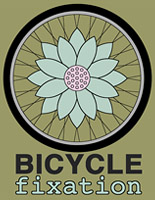Los Angeles, 2009
The growth of cycling in the US is accompanied, inevitably, by calls for more cycling infrastructure--be it lanes, sharrows, bike parking, bicycle boulevards, bikestations, or whatever. And this in turn engenders an inevitable backlash, often from rabid anti-taxers who want no government spending on anything (except, of course, their subsidized auto roads), or by merchants, who fear that repurposing automobile infrastructure such as lanes and onstreet parking for cyclist's use will choke off the flow of customers to their stores.
However, it turns out that both these counter-arguments are pathetically fallacious: adding bicycle-friendly features to the transport network can save cities money in the long run, and cyclists seem to make better customers than drivers!
The environmental benefits of practical cycling are well known--not only do bicycles use no fuel, they require very little space for parking and for travel. While it seems paradoxical that cycling groups are asking for infrastructure that requires yet more paving, in the long run, more cycling will lessen the demand for the far more extensive acres of asphalt cars require, thereby saving the city money.
Likewise for health: though many fear cycling statistics show that it is no more dangerous than driving in the US. (In northern Europe it is less dangerous than driving!) And the increase in cardiovascular and psychological health resulting from cycling (or walking, of course) reduces public (and personal) health costs.
The bicycle is the most efficient machine ever devised, losing only 2% of the energy input at the pedals by the time the rubber hits the road. Nothing else even comes close.
In fact, cycling is so efficient that if you want to lose weight, walking is better--cycling uses 1/3 the calories per mile at four to five times the speed of shoe leather. But it is precisely this combination of speed and efficiency that makes it feasible to cycle instead of driving, when you would simply be sitting on your posterior for those same miles. You can also carry astounding quantities of stuff on a bicycle, if you're of a consumerist bent--I recently road-tested a Swedish cargo bike on which I carried my wife and a load of groceries that included a watermelon, for a total load of 150 pounds!
But something else happens when you ride instead of drive, something of particular interest to a city's business community: at cycling's transportational pace of 15mph, you find yourself much more aware of the world you inhabit--the weather, the state of the road, your neighbors, your city's architecture, and so forth. You enrichen your life by seeing things you otherwise would have missed.
Including stores. For it turns out that cycling does more than save the world and enrichen your soul: it can save economies and enrich your business community.
Our northern rival recently discovered this, thanks to the San Francisco County Transportation Authority's On-Street Parking Management and Pricing Study. To quote a recent report: "The SFCTA study looked in depth at parking issues in four San Francisco neighborhoods--Cow Hollow, West Portal, Hayes Valley, and Bernal Heights. The study surveyed parking availability, parking turnover, and parking duration, and interviewed merchants and residents. Among the study's findings were that both businesses and residents were willing to pay more for parking in return for greater availability, and that while merchants in the four neighborhoods thought that 72% of their customers 'drove exclusively' to the neighborhood, over 70% of their customers walked, cycled, or took transit." [Link]
A study in Toronto, reviewing the feasibility of removing parking to make room for bike lanes on that city's Bloor Street, discovered that pedestrians and cyclists not only comprised the majority of visitors to the Annex neighborhood's local merchants, but spent more money per month and per visit than did drivers or transit users.
To quote: "The general finding from this study is that pedestrians, cyclists and transit users account for the bulk of retail spending on Bloor Street West in the Annex neighbourhood. In fact, there is evidence to suggest that efforts to attract more pedestrians and cyclists will have a more positive economic impact on businesses than maintaining the existing parking on the street. On this section of Bloor Street, the existing parking demand can be accommodated by a reduced number of on-street parking spaces combined with the existing off-street parking spaces."
The entire report (a PDF) is very long, but worth reading. [Link]
And it won't hurt that cycling cultures seem to be happy and productive ones: Holland, in this recessionary year of 2009, has an unemployment rate of just 3.3%, and Denmark, another cycling powerhouse, of only 5.7%. And Denmark's GDP per capita is $68,000, compared with the US's $47,000.
Cycling is just one facet of those countries' economies, of course. But the point is, building bicycle transportation infrastructure won't break the bank--in fact, it may help government save money, and businesses make money.
This article first appeared in slightly different form in the Los Angeles Business Journal

